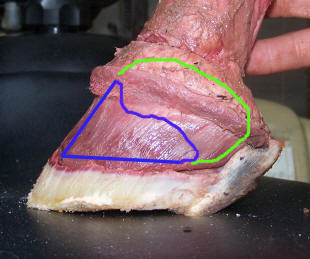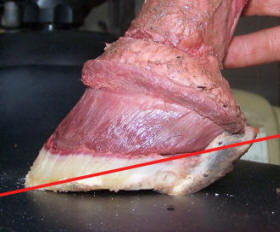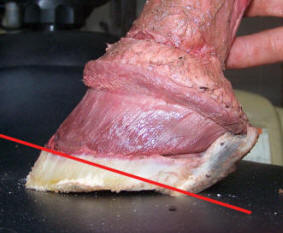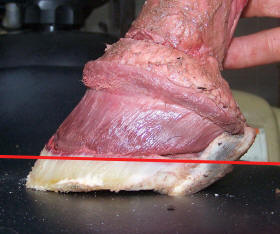Toe and Heel Length
(11-25-06)
Pete Ramey
Copyright 2006
This article was written to provide additional clarity to the previous article, Reversing Distal Descent http://www.hoofrehab.com/DistalDescent.htm. Please read it first.
If you've read my work before, you
know how much I stay away from "always and never"— the horses
taught me that. In this article you'll read those words
repeatedly. Please know I do not use them lightly.
Most hoof care professionals were taught to
trim hooves to certain parameters based on toe length and heel
height. The target ranges vary from method to method, but most
call for toe lengths from 3 to 3-1/2 inches and heel lengths
from near zero to 2 or more inches. The problem with trimming
theories that enforce specific hoof lengths based on
measurements from the coronet to the ground is that they don't
take into account the fact the coronet is highly dynamic and
easily moveable. Excess pressure on the walls can quite easily
displace the coronet upward. It is the last place we should
measure from! I'm going to try to spin your brain into
seeing past the coronet and the hoof wall; everyone who cares
for horses' hooves needs to see the internal structures first.
The hoof wall was never intended to bear
the horse's weight alone. The sole, frog and bars are supposed
to work in unison with the hoof walls to support the impact
energy of the horse. It is common, however, for traditional
farriers to force the hoof walls to unnaturally bear the entire
burden of support. Over time, these unnatural loads on the walls
push the coronet to a higher position (relative to the coffin
bone). To put it another way, the entire horse drops through the
hoof capsule. Traditionally, this is thought of only as an event
associated with severe founder, but it is actually very common
to varying degrees in domestic hooves that are perceived as
perfectly sound. They often get along this way for years before
it catches up to them and causes severe lameness (actually, the
lameness is typically caused when the farrier doesn’t realize
the horse has sunk through the hoof capsule and then cuts the
sole off in the name of shortening the foot).
At the toe, this type of damage is readily
visible on radiograph if a radiopaque marker is accurately
placed at the hairline (Please see the previous article
Reversing Distal Descent). The coronet height and the coffin
bone height should be very close to level with each other.
2011 Edit: since writing this article, the term CE –
coronet to extensor process (the top of the coffin bone)
measurement has come into common usage. This is measured from a
scaled lateral radiograph by marking the exact base of the hair
follicles at the center of the toe and comparing this height to
the height of the top of the extensor process.
The foundation for the back of the foot is
cartilage rather than bone, so it doesn't show up on radiograph,
making it more difficult to interpret. When people debate
proper heel height or toe length without considering where
the highly mobile coronet currently resides they are missing a
critically important point. It is very common for soles
to be thinned to dangerous levels in an attempt to achieve
certain toe lengths. It is equally common for the sole in the
back of the foot to be dangerously thinned to achieve certain
heel heights as well.
Every hoof practitioner
should do as many cadaver dissections as possible. This is the best way to
develop an understanding of the internal structures. Here I have removed the
'skin' -- which is precisely what the hoof wall, sole and frog are.

Left
photo: (please excuse my lack of talent with graphics) Blue line
represents the coffin bone; green line represents the lateral cartilages.
Both "foundations" are covered by a thin (3/16th inch) layer of living
tissue (the corium). It is very important to understand the shape of the
internal structures. A horse must always have at least 1/2-inch of
densely-callused sole and frog covering them – 3/4-inch is even better).
Every situation
is different, but every horse needs adequately thick and
densely callused sole under the coffin bone and the lateral
cartilages. This should be priority #1 in all circumstances.
Once that is achieved, if the heel or toe wall length is "too
long" the coronet has been pushed into an unnaturally high
position by excess wall pressure over time. Providing proper
movement, diet and trimming will allow the coronet to relax to a
natural position over time, thus shortening the wall length. The
flip-side of this is that if you thin the soles to achieve
'correct' wall lengths first, the horse will work overtime to
replace the lost armor plating and the 'extra' length you
removed will keep coming back indefinitely, often getting worse.
How do you apply this? First, forget about
the length of the hoof walls (toe, heel, quarters...
everywhere). The top priority is to ensure there is adequate
(but not excessive) sole under the coffin bone and lateral
cartilages. There are at least two accurate ways to judge sole
depth in the field. First and foremost is sole callusing.
Barefoot horses that move correctly tend to callus their own
soles very uniformly and in a 1/2- to 5/8-inch thickness and
this callus shouldn't be molested with the tools. Look for this
callused sole plane and you'll find it is almost always parallel
to the internal structures. Exceptions occur when the horse has
had its soles thinned by the previous trimmer, or when the horse
is moving incorrectly. A common example is the horse that lands
toe-first due to heel pain. The soles at the toe will almost
always be worn thinner and the coffin bone will almost always be
driven to a very low position in the hoof capsule. Horses with
angular limb deformities may also wear the sole on one side to a
thinner depth, but this is very rare. It can go the other way as
well: Shod horses and sedentary barefoot horses (particularly in
arid regions) may have false soles or layers of old growth that
should generally be removed.
For sorting through these exceptions, plan
B is to judge sole depth using the collateral grooves (frog/sole
junction). Their deepest point along the sides of the entire
frog is consistently around 7/16th inch away from the corium
covering the coffin bone and lateral cartilages so they provide
an excellent locator. The more sole depth there is in the
outer perimeter adjacent to the white line, the higher the
collateral grooves will be lifted off the ground (plus any wall
height standing longer than the sole). In a healthy hoof with
adequate sole depth, the sole adjacent to the white line should
lift the collateral grooves about 3/4-inch off the ground in
front, and around an inch off the ground at the back of the foot
at the deepest point beside the bars (This extra height at the
back of the foot allows for expansion and a ground parallel
collateral groove at peak impact loads).
The collateral groove is a very accurate
evaluation for sole thickness in the front of the foot, because
the coffin bone is [more] rigid, but the flexion of the lateral
cartilages makes it trickier to gauge in the back of the foot.
For instance, in a hoof with contracted heels the lateral
cartilages will be 'bent' up into a higher dome. This may mean
1-1/2 inches of collateral groove height is necessary to provide
adequate sole thickness adjacent to the white line. Therefore
the callused sole plane is the best guide in the back of the
foot and the collateral groove depth adds additional
information. The collateral groove depth is the most accurate
guide in the front of the foot, with the callused sole plane
providing the back-up information (Please read the previous
articles, Understanding the Soles and
One Foot for all
Seasons for clarity).
So by using this information to judge sole depth covering the internal structures, you can then determine whether the coronet is displaced to an unnaturally high position. If the coronet is in a correct position and adequate sole thickness is present, toe lengths (based on measurements to the hairline) should then fall between 3 and 3-1/2 inches and heel heights should be around one inch in most horses; the shorter the better, really. If the wall lengths are longer, either the coronet is vertically displaced, the toes are flared from the coffin bone, and/or the heels are contracted (raising the vault of the lateral cartilages). In none of these cases is it even remotely correct to thin the sole to achieve proper wall lengths. That would just add insult to injury. The wall length (at heel or toe) should be the very last thing we judge or act upon, but so often people attack it first at the expense of the sole. Why? There are hundreds of different books that teach us to do so!
When you realize how dynamic the coronet actually is, it becomes sobering to think how many rash decisions are traditionally made from the measure of hoof wall length. Here, I am moving the coronet almost an inch with light thumb pressure.
The same
information and insight into the internal foundation will help
you with the toughest medial/lateral balance problems. First
understand no one can balance a foot. It simply isn't possible.
If you show me a 'perfectly' balanced foot, I'll lead the horse
through a turn and we'll watch the heels collide with the ground
out of unison. So what is proper heel balance? Proper heel
balance is having the exact same amount of sole covering the
lateral cartilages on both sides of the foot, and the same
amount of hoof wall on each side protruding above that sole
plane. (Please read the previous articles
Heel Height, the
Deciding Factor and Mediolateral Balance
for clarity
and exceptions)
The horse needs for both heels to impact
the ground simultaneously as often as possible, but varying
terrain, the type of movement/work the horse does and the
straightness of the limbs makes every impact a little different
in the real world. The natural flexion (twisting) of the lateral
cartilages conforms to the ground and easily accommodates this,
but for additional help they also do an amazing thing. The
lateral cartilages semi-permanently adjust their rest
position to accommodate the most common impact of an individual
hoof. A hoof that usually hits the ground slightly crooked
because of an angular deformity or body issue will adjust its
lateral cartilages accordingly. Also, a perfectly
straight-legged horse can make such adjustments due to its most
common work. For instance at the trot, a horse should impact the
ground with its hind limbs underneath himself (like a
tightrope walker). Horses that usually work at the trot
(endurance horses, trotters...) will develop lateral cartilages
that are in a lower position on the inside (or from the
trimmer's perspective; the hoof will appear longer on the
inside) so that both heels hit the ground simultaneously during
this movement. This is a good thing and should be allowed and
embraced by the trimmer (but do not let it run away out
of control).
If the trimmer/farrier doesn't consider the
movement of the horse and tries to fight this adaptation by
forcing the foot to be balanced while standing square, the
resulting "excess wall" (from the horse's perspective) will
cause the coronet to push upward over time. Again this is very
common and again the hairline or coronet balance should be the
last thing we evaluate; it is only a view of the past care. I
have seen many horses with horrifically displaced/imbalanced
coronets, but have never seen a situation that required one
lateral cartilage to be covered with more sole than on the other
side of the same foot.
Therefore, we're right back to the same
spot when trying to sort through heel balance issues: Use the
callused sole plane and collateral groove depths to ensure you
have the same amount of sole on each side and do nothing more
than monitor the hairline height off the ground at the heels.
The hairline/ground height will equalize over time if the horse
is allowed to wear the heel balance that agrees with its
movement and the position of the lateral cartilages. [This
can/should be accelerated by putting a more aggressive (steeper)
mustang roll/bevel on the side that has the high coronet].
Every horse and every hoof is different. I
still run into new situations that leave me "head-scratching"
every day, so there is no way to sit down and write about each
possible situation you'll encounter in the real world. I can
tell you that the more you learn to "see through" the hoof wall
and visualize the internal structures, the better you will be at
sorting through every hoof issue. The best help for this is by
performing as many hoof dissections as possible. Never bury a
hoof; you'll be missing out on a chance to make yourself better
for the horses in your care.
Besides CE, there are countless other factors make the correct toe
length and heel height a variable. Sensitive and underdeveloped lateral
cartilages and digital cushions may cause a need for a higher heel, as may
ligament, tendon, joint and muscular issues. Flared or rotated toe walls can
dramatically effect toe length measurements. The list goes on and on.
But with all the "ifs, ands and buts" we
have to sort through every day, at least one thing is consistent. It is
simply never desirable to thin the soles beyond their 5/8”-3/4” natural
thickness. The left photo shows the naturally thick and uniform sole of a
healthy horse. The other three (red lines) show very common mistakes I see
every day. How is it even possible for a professional to do this? A vast
majority of professionals were trained to place top priority in heel and toe
wall lengths/angles, sacrificing the sole thickness. Many barefoot trimmers
will cut into or near the corium trying to shorten heel walls and bars. Many
farriers will routinely take much needed sole from the toe, trying to
shorten the toe walls or raise toe angles. I hope this article makes this a
little less common.



Burn these pictures into your
brain and every time you see the sole being trimmed, always ask yourself
which of the four pictures is most similar to the end result.

